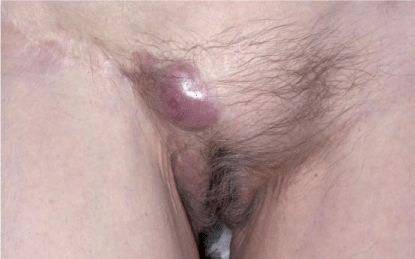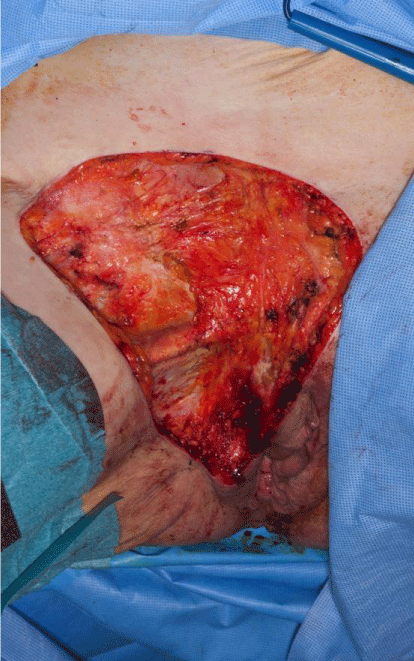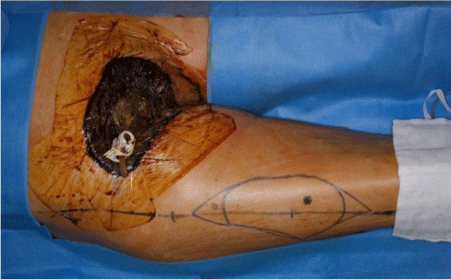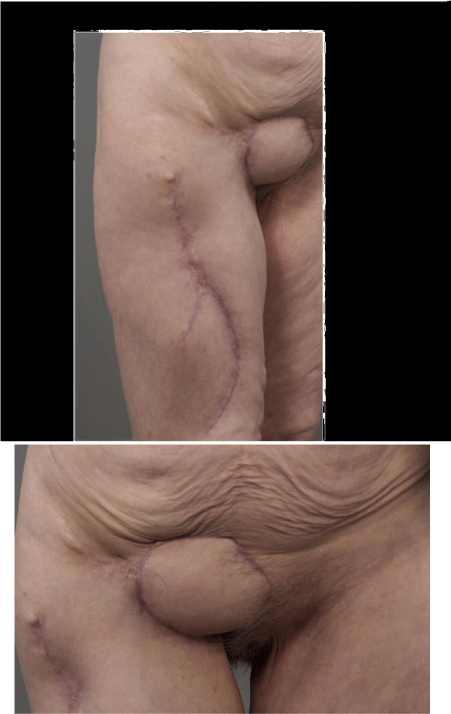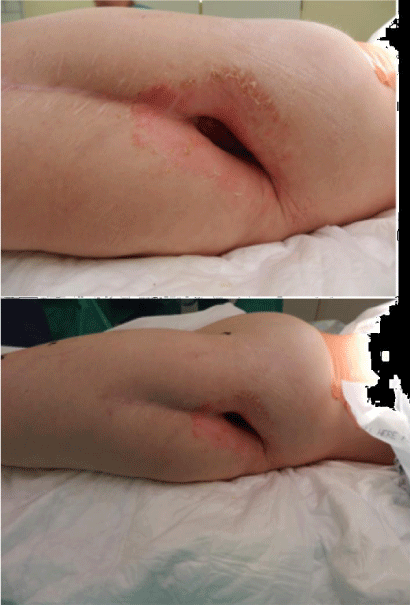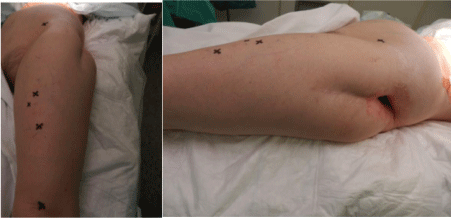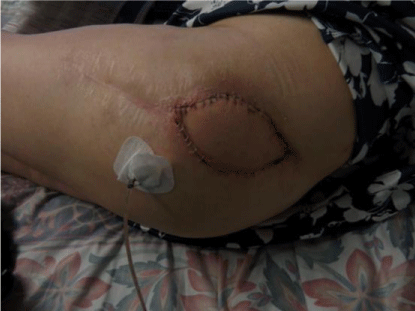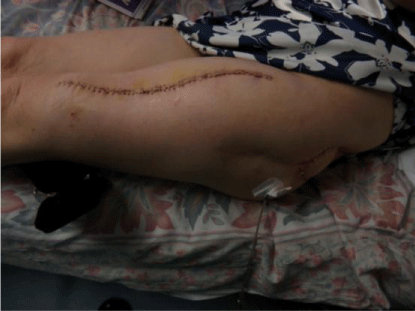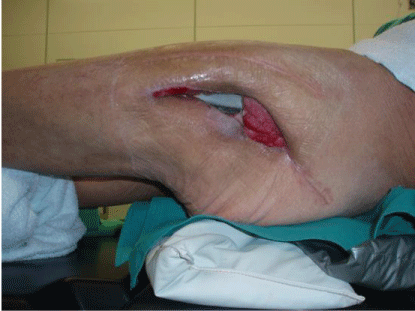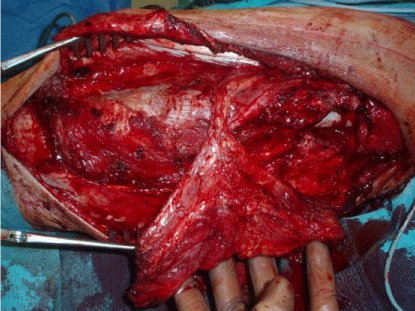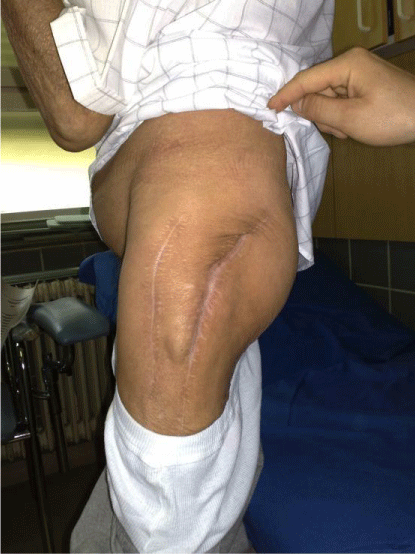Research Article
360° of Freedom in Chimeric Pedicled Vastus Lateralis-ALT Perforator Flap for Reconstruction in Patients with Advanced or Recurrent Malignancies
Kosutic D1*, Mulh R2, Apostolos V1 and Solinc M2
1Department of Plastic and Reconstructive Surgery, Christie NHS Foundation Trust, Manchester, UK
2Department of Plastic and Reconstructive Surgery, Clinical Centre Ljubljana, Slovenia
*Corresponding author: Damir Kosutic, Consultant Plastic & Reconstructive Surgeon, Christie NHS Foundation Trust, Wilmslow Road, M20 4BX, Manchester, UK
Published: 14 Apr, 2017
Cite this article as: Kosutic D, Mulh R, Apostolos V, Solinc
M. 360° of Freedom in Chimeric
Pedicled Vastus Lateralis-ALT
Perforator Flap for Reconstruction in
Patients with Advanced or Recurrent
Malignancies. Clin Surg. 2017; 2: 1401.
Abstract
Introduction: Defects following resections of advanced malignancies and particularly sarcomas
are often challenging from functional and reconstructive point of view. In recent years, a chimeric
vastus-lateralis-fascio-cutanoues ALT was described, allowing greater versatility and more
sophisticated reconstructions. We report our experience with pedicled chimeric vastus-lateralis
muscle-facioucutanous ALT pedicled flap for reconstruction following resection of sarcomas and
advanced melanomas or complications of sarcoma resections in a large tertiary cancer centre with
the longest ever follow up published so far.
Methods: From 2009 to 2016, 29 pedicled perforator chimeric vastuslateralis muscle-fascioucutaneous
ALT flaps were used to reconstruct defects following primary and recurrent sarcomas and advanced
melanomas in 29 patients. Data on tumor type, defect and vascular anatomy, number of perforators
used for the flap, arc of rotation, comorbidities, complications, donor site morbidity and long term
outcomes were collected prospectively and analyzed.
Results: Defects involved pubic and suprapubic areas, lower abdomen, vulvar region, peritrochanteric
area, groin, supra-patellar, upper and lower thigh and lateral aspect of knee joint. All
29 flaps completely survived in all patients. All donor sites healed primarily. There were no local
recurrences. Patients (7) developed metastasis within 2 years from resection and reconstruction
and all of them were dead within 1 year from the date metastatic spread was diagnosed. Remaining
patients on long-term follow up continue to have excellent functional and aesthetic outcome.
Conclusion: We suggest pedicled chimeric vastuslateralis-ALT flap as an excellent option for
reconstruction of defects following removal of advanced or recurrent malignancies in elderly
patients.
Introduction
Defects following curative resections of advanced malignancies and particularly soft-tissue and bony sarcomas are often challenging from the functional and reconstructive point of view. This is even more true in frail and elderly population we often treat in tertiary Cancer Centre setting. Serious comorbidities and, not infrequently, relatively high local recurrence rates for some sarcoma subtypes, make the use of free tissue transfers in this subgroup of patients a less desirable option. Vastus lateralis flap and its most popular variant- ALT (antero-lateral thigh perforator flap) have, since its description by Song [1], gained a great popularity as a free or pedicled flaps. In recent years, a chimeric vastus-lateralis-fascio-cutanoues ALT was described, predominantly as a free flap [2], allowing greater versatility and more sophisticated reconstructions. We report our experience with pedicled chimeric vastus-lateralis muscle-facioucutanous ALT pedicled flap for reconstruction following resection of sarcomas and advanced melanomas or complications of sarcoma resections in a large tertiary cancer centre with the longest ever follow up published so far.
Patients and Methods
From June 2009 to August 2016 29 pedicled perforator chimeric vastus lateralis musclefascioucutaneous anterolateral thigh flaps were used to reconstruct defects following primary and recurrent sarcomas and advanced melanomas in 29 patients (all unilateral cases). Data on tumor type, anatomy of the defect, vascular anatomy and number of perforators used for the flap, arc of rotation, comorbidities, complications, patient demographics, donor site morbidity and long term outcomes were collected prospectively and analyzed. Dominant skin perforator was located using usual anatomical landmarks and hand-held Doppler only in the first 10 cases, while CT-angiogram was used in the remaining 19 cases. Selection of perforators supplying the muscle component of the flap was performed intraoperatively, depending on their location, distance from the skin perforator and requirements of the defect. Dissection was performed from distal to proximal in all cases for the skin component while dissection of muscle perforators was performed from proximal (main pedicle) to distal, in order to maintain good control of haemostasis and avoid unnecessary damage to the muscle component of the flap.
Results
24 patients underwent resection for sarcomas (18 primary and 6 recurrent), 4 patients had resection of advanced melanoma and one patient had resection of metastatic SCC. In the sarcoma group there were 12 patients with DFSP (Dermatofibrosarcoma protuberans)- (Figures 1-4), 9 patients with leyomyosarcoma and 3 patients with osteosarcoma. Defects involved pubic and suprapubic areas, lower abdomen, vulvar region, peri-trochanteric area, groin, supra-patellar, upper and lower thigh and lateral aspect of knee joint (Table 1). There were 27 proximally based and 2 reversed flow-distally based flaps. All flaps were raised with a single separate perforator supplying skinisland and 2-4 separate perforators supplying the muscle component of the flap. 21 flaps were rotated clockwise and 8 were rotated anticlockwise (Figures 5-8). Arc of rotation varied between 60° and 180° in both clockwise and anti-clockwise direction. One skin island was removed following harvest as muscle-only flap was sufficient for reconstruction under the directly closed skin edges (Figures 9-12). All 29 flaps completely survived in all patients. 1 patient developed local wound infection that was treated successfully with antibiotics only. All donor sites healed primarily. 14 Patients were classified as ASA score III, 5 as ASA IV, 4 as ASA II and 6 as ASA I, due to their comorbidities. Full range of motion in hip and knee joint was observed in all patients in the long term follow up, which varied from 31 to 98 months (average 64 months of follow up). Histopathological margins were clear following resection in all patients. There were no local recurrences. 7 patients developed metastasis within 2 years from resection and reconstruction and all of them were dead within 1 year from the date metastatic spread was diagnosed. Remaining patients on long-term follow up continue to have no surgery related issues with mobility and excellent functional and aesthetic outcome.
Figure 1
Figure 1
Recurrent DFSP (Dermatofibrosarcoma protuberans) affecting
pubic and supra-pubic areas and extending into the vulva.
Figure 2
Figure 3
Figure 4
Discussion
Reconstruction of defects following resection of advanced and recurrent malignancies in elderly patients is often limited by previous surgeries, scars, serious comorbidities and reduced mobility. Under these circumstances, there is a need for reliable, straightforward and not overly lengthy procedure with low donor site morbidity. Vastus lateralis flap and its fasciocutaneous counterpart-anterolateral thigh perforator (ALT) flap have been extensively utilized as free [3] or pedicled [4] flaps in reconstructing both traumatic and oncological defects. More recently, a chimeric version of these flaps have been used for head and neck [5], lower limb [6] and trunk, including lower abdomen, perineum [7] and vulvar area [8]. Separate blood supply to muscle part of the flap and skin component creates more degrees of freedom and customized flap design [9], often required in oncological reconstructions. On the other hand, simultaneous harvest of muscle component may make the blood supply to the skin island more robust and reliable [10]. In our experience, Skin Island can safely be raised on a single skin perforator regardless of the flap size even in elderly patients. On the other hand, we aimed to include at least two branches supplying the muscle component due to higher physiological demand and more difficult monitoring. Inclusion of muscle makes the reconstruction more reliable as it may serve as a back-up, should the skin component undergo necrosis. This is particularly useful in peri-trochanteric defects (Figure 9-11). In our experience, the arc of rotation covers 360° (180° clockwise and anti-clockwise). However, if flap is rotated anti-clockwise, the lowest-available perforator needs to be chosen for the skin-component (Figures 5-8). Additional benefit of raising the part of vastus lateralis is certainly easier closure of donorsite. We have not observed any significant weakness in leg extension following inclusion of vastus lateralis or its part in any of our reconstructions, which is in accordance with what has been reported previously. This is particularly important in frail and elderly group of patients that usually have some mobility issues; we commonly treat in tertiary cancer centre. Our series confirms these findings as all of our patients returned to their pre-operative range of motion. We have not observed any vascular/microvascular problems in our series which highlights the quality of blood supply to this flap and the fact that lateral circumflex femoral artery axis may indeed be less frequently affected by atherosclerotic changes even in elderly. Pedicled chimeric vastus lateralis-ALT flap should be in our opinion, considered a first-line option in oncological reconstruction for a variety of defects within the reach of LCFA (lateral circumflex femoral artery) axis, as it provides more degrees of freedom than any other flap. It is easy and relatively quick to harvest, has a robust reliable blood supply and no negative effects on post-operative mobility.
Figure 5
Figure 5
A) and B) Chronic Peri-trochanteric defect following sarcoma
excision, infection with skin necrosis and wound breakdown.
Figure 6
Figure 7
Figure 8
Figure 9
Figure 9
Exposed hip-prostheses following infection and soft tissue necrosis
after bony sarcoma resection.
Figure 10
Figure 11
Table 1
Conclusion
We suggest pedicled chimeric vastus lateralis-ALT flap as a first line option for reconstruction of defects following removal of advanced or recurrent malignancies in elderly patients due to its multiple qualities, low donor-site morbidity and no negative effects on patient mobility post-operatively.
Acknowledgement
We are grateful to Medical Illustration Department of Christie Hospital for providing high quality images of our patients who all gave consent for publication.
References
- Song YG, Chen GZ, Song YL. The free thigh flap:a new flap concept based on the septocutaneous artery. Br J Plast Surg. 1984;37:149-59.
- Kerawala CJ. Reconstruction of defects after hemiglossectomy using a chimeric vastus lateralis free flap. Br J Oral Maxillofac Surg. 2009;47:126-8.
- Gedebou TM, Wei FC, Lin CH. Clinical experience of 1284 free anterolateral thigh flaps. Handchir Mikrochir Plast Chir. 2002;34:239-44.
- Hallock GG. The proximal pedicle anterolateral thigh flap for lower limb coverage. Ann Plast Surg. 2005;55:466-9.
- Shaw RJ, Batstone MD, Blackburn TK, Brown JS. The anterolateral thigh flap in head and neck reconstruction:"pearls and pitfalls". Br J Oral Maxillofac Surg. 2010;48:5-10.
- Dayan JH, Lin CH, Wei FC. The versatility of the anterolateral thigh flap in lower extremity reconstruction. Handchir Mikrochir Plast Chir. 2009;41:193-202.
- di Summa PG, Tremp M, Schwabedissen MZ, Schaefer DJ, Kalbermatten DF, Raffoul W. The Combined Pedicled Anterolateral Thigh and Vastus Lateralis Flap as Filler for Complex Perineal Defects. Ann Plast Surg. 2015;75:66-73.
- Gentileschi S, Servillo M, Garganese G, Simona F, Scambia G, Salgarello M. Versatility of pedicled anterolateral thigh flap in gynecologic reconstruction after vulvar cancer extirpative surgery. Microsurgery. 2016.
- Lin YT, Lin CH, Wei FC. More degrees of freedom by using chimeric concept in the applications of anterolateral thigh flap. J Plast Reconstr Aesthet Surg. 2006;59:622-7.
- Posch NA, Mureau MA, Flood SJ, Hofer SO. The combined free partial vastus lateralis with anterolateral thigh perforator flap reconstruction of extensive composite defects. Br J Plast Surg. 2005;58:1095-103.

